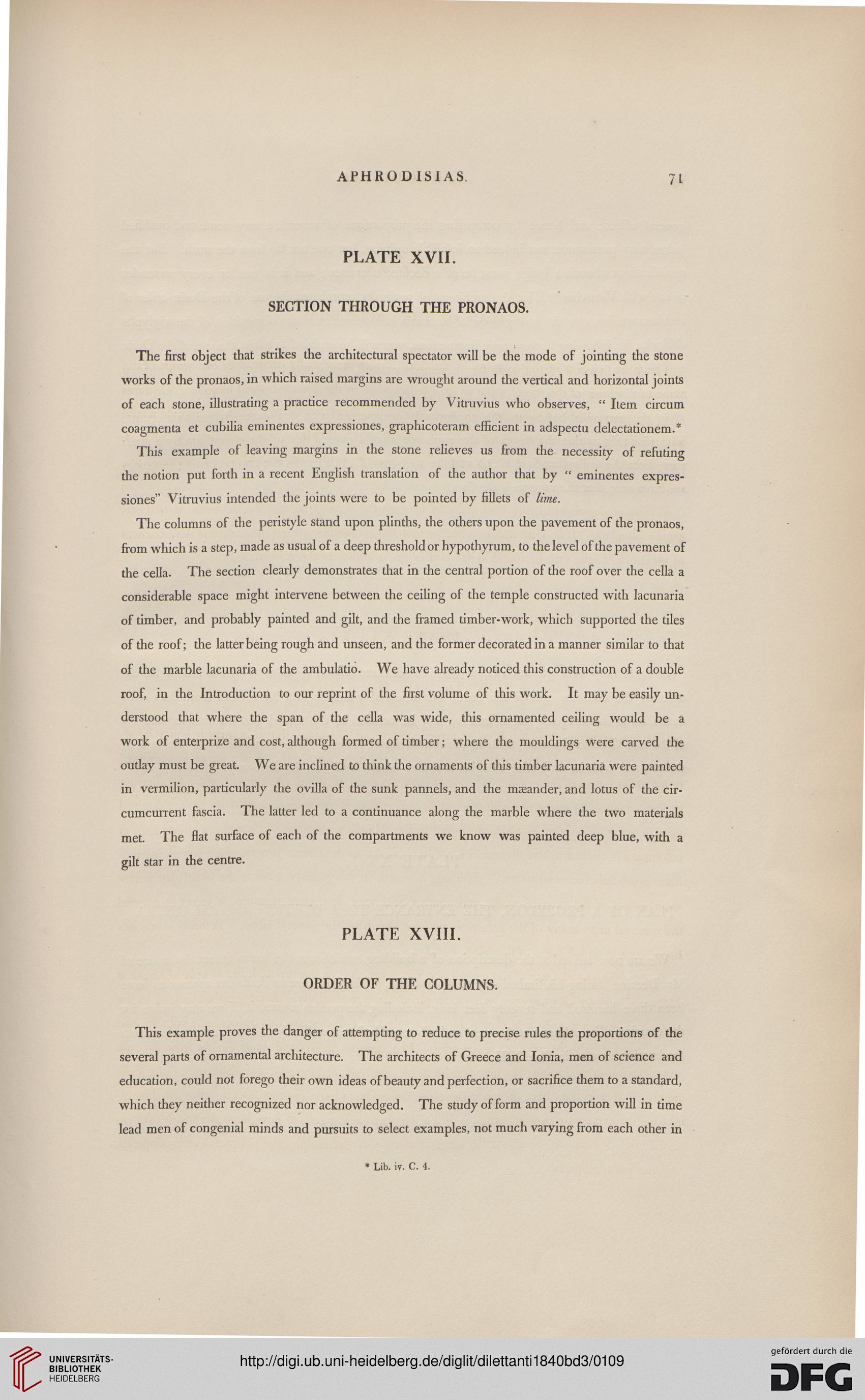APHRODISIAS.
7t
PLATE XVII.
SECTION THROUGH THE PRONAOS.
The first object that strikes the architectural spectator will be the mode of jointing the stone
works of the pronaos, in which raised margins are wrought around the vertical and horizontal joints
of each stone, illustrating a practice recommended by Vitruvius who observes, " Item circum
coagmenta et cubilia eminentes expressiones, graphicoteram efficient in adspectu delectationem.*
This example of leaving margins in the stone relieves us from the necessity of refuting
the notion put forth in a recent English translation of the author that by " eminentes expres-
siones" Vitruvius intended the joints were to be pointed by fillets of lime.
The columns of the peristyle stand upon plinths, the others upon the pavement of the pronaos,
from which is a step, made as usual of a deep threshold or hypothyrum, to the level of the pavement of
the cella. The section clearly demonstrates that in the central portion of the roof over the cella a
considerable space might intervene between the ceiling of the temple constructed with lacunaria
of timber, and probably painted and gilt, and the framed timber-work, which supported the tiles
of the roof; the latter being rough and unseen, and the former decorated in a manner similar to that
of the marble lacunaria of the ambulatio. We have already noticed this construction of a double
roof, in the Introduction to our reprint of the first volume of this work. It may be easily un-
derstood that where the span of the cella was wide, this ornamented ceiling would be a
work of enterprize and cost, although formed of timber; where the mouldings were carved the
outlay must be great. We are inclined to think the ornaments of this timber lacunaria were painted
in vermilion, particularly the ovilla of the sunk pannels, and the maeander, and lotus of the cir-
cumcurrent fascia. The latter led to a continuance along the marble where the two materials
met. The flat surface of each of the compartments we know was painted deep blue, with a
gilt star in the centre.
PLATE XVIII.
ORDER OF THE COLUMNS.
This example proves the danger of attempting to reduce to precise rules the proportions of the
several parts of ornamental architecture. The architects of Greece and Ionia, men of science and
education, could not forego their own ideas of beauty and perfection, or sacrifice them to a standard,
which they neither recognized nor acknowledged. The study of form and proportion will in time
lead men of congenial minds and pursuits to select examples, not much varying from each other in
* Lib. iv. C. 4.
7t
PLATE XVII.
SECTION THROUGH THE PRONAOS.
The first object that strikes the architectural spectator will be the mode of jointing the stone
works of the pronaos, in which raised margins are wrought around the vertical and horizontal joints
of each stone, illustrating a practice recommended by Vitruvius who observes, " Item circum
coagmenta et cubilia eminentes expressiones, graphicoteram efficient in adspectu delectationem.*
This example of leaving margins in the stone relieves us from the necessity of refuting
the notion put forth in a recent English translation of the author that by " eminentes expres-
siones" Vitruvius intended the joints were to be pointed by fillets of lime.
The columns of the peristyle stand upon plinths, the others upon the pavement of the pronaos,
from which is a step, made as usual of a deep threshold or hypothyrum, to the level of the pavement of
the cella. The section clearly demonstrates that in the central portion of the roof over the cella a
considerable space might intervene between the ceiling of the temple constructed with lacunaria
of timber, and probably painted and gilt, and the framed timber-work, which supported the tiles
of the roof; the latter being rough and unseen, and the former decorated in a manner similar to that
of the marble lacunaria of the ambulatio. We have already noticed this construction of a double
roof, in the Introduction to our reprint of the first volume of this work. It may be easily un-
derstood that where the span of the cella was wide, this ornamented ceiling would be a
work of enterprize and cost, although formed of timber; where the mouldings were carved the
outlay must be great. We are inclined to think the ornaments of this timber lacunaria were painted
in vermilion, particularly the ovilla of the sunk pannels, and the maeander, and lotus of the cir-
cumcurrent fascia. The latter led to a continuance along the marble where the two materials
met. The flat surface of each of the compartments we know was painted deep blue, with a
gilt star in the centre.
PLATE XVIII.
ORDER OF THE COLUMNS.
This example proves the danger of attempting to reduce to precise rules the proportions of the
several parts of ornamental architecture. The architects of Greece and Ionia, men of science and
education, could not forego their own ideas of beauty and perfection, or sacrifice them to a standard,
which they neither recognized nor acknowledged. The study of form and proportion will in time
lead men of congenial minds and pursuits to select examples, not much varying from each other in
* Lib. iv. C. 4.




